Overview
The Google Autocomplete component provides a straightforward solution for integrating Google Places API with Vue.js applications. This lightweight wrapper simplifies the implementation of location-based auto-suggestions, making it easier for developers to enhance user experience without getting bogged down in complex examples. Whether you’re an experienced Vue.js developer or just getting started, this component offers a methodical approach to incorporating autocompletion features into your project seamlessly.
By creating a bridge between Vue.js and the Google Places API, this package allows you to fetch address suggestions interactively. It’s perfect for applications where user input of location information is essential, such as reservation systems, e-commerce platforms, or delivery services. With straightforward installation and setup instructions, you’ll have the component up and running in no time.
Features
Easy Integration: The package is designed as a Vue.js wrapper around the Google Places API, enabling quick integration with minimal friction.
Event Management: Utilizes the Vuemit library for efficient event handling between the Google Autocomplete component and its parent component, enhancing communication and responsiveness.
Configuration Options: The component allows custom configurations through a props system, enabling tailored experiences for your users based on specific needs.
Server-side Validation: Integrates with the Places Validation library for Laravel, ensuring that the addresses submitted by users are valid and reliable.
CSS Customization: Supports passing custom CSS classes through the
classprop, allowing for easy styling to match your application’s design.Live Demos and Examples: Accessible examples demonstrate the installation and implementation process, guiding users through each step of the setup.
Open Source Contribution: Encourages community engagement by allowing developers to fork the project and contribute with enhancements and new features.




